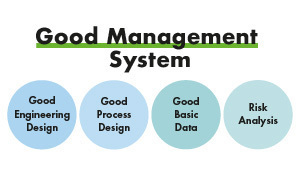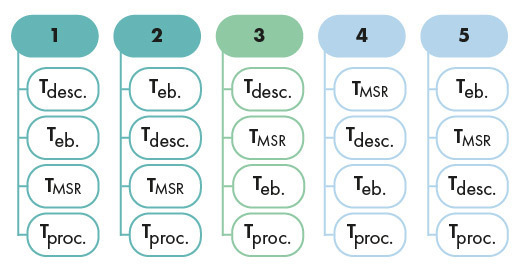Process Safety as a differentiating key factor
The Chemical industry has always been considered a focus of concern for the general population and especially for the surrounding population due to the potential severity of an accident. Unfortunately, recent examples related with chemical processes or substances have contributed to it.
Step by step, chemical companies have improved their safety standards in order to reduce the frequency and the severity of potential incidents. Therefore, methods like the Hazard and Operability Study (better known as HAZOP) are used by large companies to make their processes safer with the environment and people in mind. However, these methods demand a huge effort for small or medium-sized chemical companies, the most common situation in Europe.
On the other hand:
- Unexpected or runaway reactions seem to be the main technical causes and
- Inadequate or incorrect process analysis, inappropriate plant design or operational procedures and inadequate instructions appear among the most common organizational causes of an accident.
How does Lebsa make its industrial activity compatible with the environment and surroundings?
With this scenario LEBSA’s team understands the importance of making their industrial activity compatible with the environment and surroundings. The importance of being a trusted partner in the global pharmaceutical market for generic API manufacturing in Europe. Therefore, a well-designed chemical process from a safety point of view appears as a strategic key factor to achieve the above mentioned goals:
- Respect for the environment and people and
- To become a flexible partner, customer-centred, and committed to successful long-term business relationships.
Regarding safety chemical processes, it’s important to figure out the most appropriate method for hazard identification to be implemented in LEBSA, a SME (Small and Medium-sized Enterprise) with a multi-purpose facility design and batch production manufacturing method. Being quite common that those used by big companies demand huge human and economic resources to be dedicated to. In this sense, the possibility to use simple tools, easy to use by non-experts in the field of safety, could be of interest for a small or medium-sized company.
Use of HarsMeth methodology for increased safety
In such situations HarsMeth methodology should be a good alternative to be taken into account. It’s a methodology for the hazard assessment of chemical processes, being well-structured to offer excellent assistance for the safety analysis of batch (as well as semi-batch processes) in an easy structured way by using basic rules and methods designed as an interface between experts and SMEs.
This method was developed by the HarsNet Network (2007) funded by the European Commission (Nomen, Sempere, Sales, & Ghinaglia, 2002), which was active between 1998 and 2002.
The hazard assessment of a chemical reaction is performed by means of a set of five checklists (Figure 1):

For new chemical processes the five checklists are put together with the method developed by Stoessel (1993) to classify the criticality of a possible runaway according to four temperature values. Depending on these values, the following five classifications are established:

Where:
Tproc: Process temperature under normal conditions.
TMSR: Maximum temperature of synthesis reaction reached after cooling system failure.
Teb: Reaction mass boiling point.
Tdesc: Descomposition temperature.
The SME solution
This philosophy based on checklists works out the above mentioned SME’s problem related with other methods: the amount of human and technical dedicated resources needed to perform a hazard analysis. HarsMeth emerges as a tool sufficiently easy to understand and quick to perform to comply with our needs. In this way, the knowledge of an external safety consultant on safety analysis and the expertise of our Operational and R&D Areas work well together within this SME hazard assessment oriented tool:
- For our Operational Staff it’s a way to better understand chemical processes and their thermochemistry, implement adequate engineering design and control systems, operational procedures and operators training.
- For our R&D Leaders it’s a useful system to perform a preliminary evaluation of possible thermal hazards of our new APIs synthesis.
In conclusion, this method has given us the opportunity to perform a detailed and complete analysis of the hazards related to LEBSA’s chemical processes. In addition, the Stoessel’s scenarios are quick and easy-to-understand methods to give an idea of the criticality of the process.
HarsMeth fits perfectly together with our quality risk analysis method based on the principles of HACCP, being our processes better designed and safer. So, we are convinced that LEBSA will appear as a trusted partner committed to successful long-term business relationships.
{ “@context”: “https://schema.org”, “@type”: “FAQPage”, “mainEntity”: [ { “@type”: “Question”, “name”: “What is the HarsMeth methodology?”, “acceptedAnswer”: { “@type”: “Answer”, “text”: “HarsMeth is a structured methodology for the hazard assessment of chemical processes, designed for batch and semi-batch operations. It provides an easy-to-use interface for SMEs to analyze potential risks in chemical reactions using checklists and basic rules.” } }, { “@type”: “Question”, “name”: “How does Lebsa ensure chemical process safety in its APIs production?”, “acceptedAnswer”: { “@type”: “Answer”, “text”: “Lebsa applies the HarsMeth methodology and Stoessel’s classification system to identify potential hazards and runaway reactions in its chemical processes. This allows for safer batch manufacturing, proper engineering controls, and operational procedures while considering environmental impact.” } }, { “@type”: “Question”, “name”: “What are Stoessel’s scenarios and why are they important?”, “acceptedAnswer”: { “@type”: “Answer”, “text”: “Stoessel’s scenarios classify the criticality of possible runaway reactions based on four temperature values: process temperature, maximum synthesis reaction temperature, boiling point, and decomposition temperature. This helps to quickly assess the risk level of chemical reactions.” } }, { “@type”: “Question”, “name”: “Why is HarsMeth suitable for small and medium-sized chemical companies?”, “acceptedAnswer”: { “@type”: “Answer”, “text”: “HarsMeth is designed to be easy to use by non-experts, requiring fewer human and economic resources than complex methods like HAZOP. It provides a structured way for SMEs to perform hazard analyses without heavy investments.” } }, { “@type”: “Question”, “name”: “How does this methodology benefit R&D and operational staff?”, “acceptedAnswer”: { “@type”: “Answer”, “text”: “For R&D, HarsMeth enables preliminary evaluation of potential thermal hazards in new API syntheses. For operational staff, it helps understand chemical processes, implement proper engineering designs, and follow safe operational procedures, improving overall safety and compliance.” } } ] }



